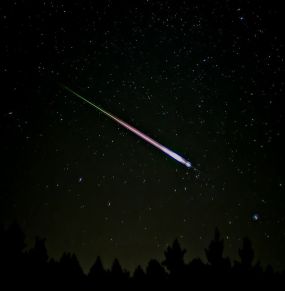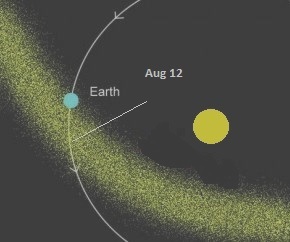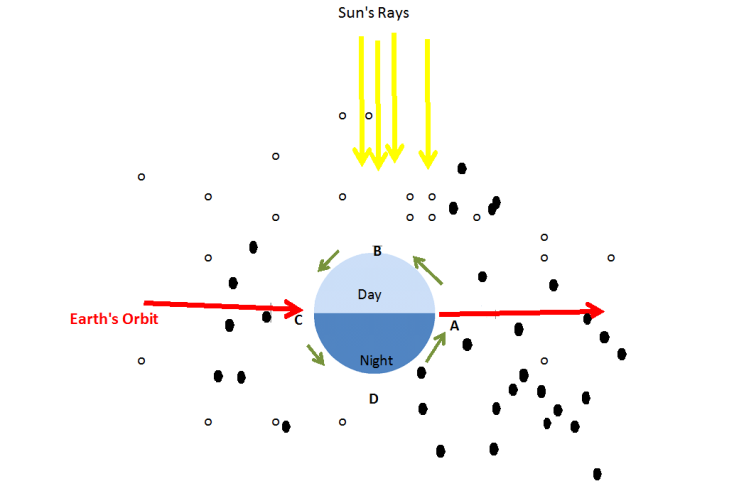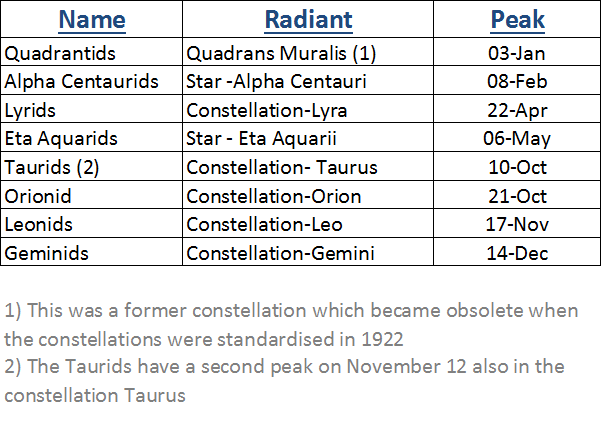For revised post containing more tips on how to view the Perseids see The Perseids 2021.
On 12 August you may be lucky enough – if it’s a clear night and you are somewhere without too much light pollution – to see a phenomenon called the Perseids, which is a meteor shower which appears at the same time every year, for reasons I will explain below. At its peak you may be able to see more than one meteor per minute.
Meteors, also known as shooting stars, are bright streaks of light lasting a few seconds. These are caused by small lumps of rock or metal called meteoroids hitting the Earth’s atmosphere at a very high speed (in the case of the Perseids around 200,000 km/h). As they pass through the atmosphere they get heated up by friction to a temperature of thousands of degrees and start to glow. This causes them to emit a streak of light as they pass through the Earth’s atmosphere. Most meteoroids get heated to such a high temperature that they vapourise and disappear from view.
Image from Wikimedia Commons
Most meteoroids are very small and are vapourised at an altitude of 50 km or higher. If the meteoroid is large enough, bigger than 1 cm in diameter, some of it can survive the passage through the Earth’s atmosphere and the part that hits the ground is known as a meteorite.
What causes the Perseids?
A comet called Swift-Tuttle orbits the Sun every 133 years. As it orbits the Sun it leaves a cloud of debris in its wake. Over a long period of time all this material ejected from the comet has formed a wide oval-shaped ring in the same orbit as the comet.
Once a year, and at the same time each year, the Earth passes through this ring of debris. When this happens some of the particles hit the Earth’s atmosphere. This is what causes the Perseids meteor shower. As you can see from the diagram the ring is fairly wide and is composed of an huge number of smaller particles. The Earth first crosses this ring in late July and takes until late August to get the other side. The thickest part of it is encountered around 12 August and this is the date on which the Perseid shower is at its most prolific.
When is the best time to observe the Perseids?
The best time of day to observe the Perseids, or in fact any meteor shower, is just before dawn. The diagram below shown the earth passing through the debris cloud.
The diagram shows the Earth rotating on its axis. B indicates midday when the Sun is highest in the sky, D indicates midnight, A indicates sunrise and C sunset.
As shown in the diagram in the hours after midnight (D to A), an observer is on the side of the Earth facing towards the Earth’s direction of travel, so there are far more meteoroids scooped up into the Earth’s atmosphere. The time of day when the most meteoroids hit the earth is actually at dawn(A), but at that time the brightness of the early morning sky makes them difficult to see. So the best time to see meteors is just before it starts getting light in the morning
If you observe a meteor shower, over a period of time, you will notice that if you follow the meteor trails backwards, all of them appear to originate from the same place. This is particularly noticeable if you take a long exposure photograph. The point in the sky where the meteors appear to originate from is called the radiant.
Image from Wikimedia Commons
The picture above shows a long exposure photograph of a meteor shower. The radiant is marked with a small circle. The Perseids’ radiant lies in the constellation Perseus, which is directly overhead around dawn at a latitude of 60 degrees North. This is bad news for my readers in the southern hemisphere, who won’t be able to see this particular meteor shower, although of course they will be able to see other meteors invisible to those of us up here.
The best way to observe the Perseids is to go a really dark place well away from light pollution. and as I said previously the best time is in the early morning just before the sky starts getting light. I would suggest about 3 hrs before sunrise. In Manchester, where Mrs Geek and I live, the sunrise on August 12 is about 5:45 am. so this will mean an extremely early start. If we are lucky enough to have a clear night you will see some meteors if you look up in the sky towards the north east. I am far too fond of my sleep to be up and about at this time, but will enjoy seeing photos and videos at a more acceptable hour, possibly even taken by Mrs Geek, although the sky is probably not dark enough round here.
When astronomers measures the strength of a meteor shower, they use a term called the Zenithal Hourly Rate (ZHR). The ZHR is the maximum number of meteors an observer could see if the sky were completely dark, there were no cloud cover and the radiant were directly overhead. The diagram below (McCure 2016) shows how the ZHR varies with date. Even if the night turns out be cloudy on 12 August, you should still be able to see some meteors either side of this date.
Fingers crossed for clear skies on the 12th, but if we are unlucky, or if you are from down under, here’s a table showing some of the other showers, although none are on average as prolific as the Perseids:
References
McClure, B (2016) Perseid outburst expected in 2016, Available at:http://earthsky.org/astronomy-essentials/everything-you-need-to-know-perseid-meteor-shower (Accessed: 25 July 2016)







Very informative on the hows and whys of meteor showers for those unfamiliar with the phenomenon. I watch the Perseids, Orionids, Leonids, and Geminids every year (weather permitting). I guess you could call it a family tradition.
LikeLiked by 1 person
wonderful post! good luck with your viewing conditions
LikeLiked by 1 person
Thanks
The Science Geek
LikeLike
Great post, really well done. Thanks for checking out mine at https://scottastronomy.wordpress.com/2016/08/09/a-less-quick-note-about-the-perseids/
LikeLike
Big Laguna Meadow Campground in SD County. Our favorite place to watch any of the meteor showers. Thanx for all the info.
LikeLike
I hope you have great viewing conditions.
The Science Geek
LikeLike
Thank you. Let’s keep our fingers crossed for a good show on the 12-th.
LikeLike
Hello! I was out last night and saw several very bright meteors. They were fast moving ones. Great article about the Perseids.
LikeLike
Reblogged this on Mohsen Behnam, PhD and commented:
Nice article!
LikeLiked by 1 person
Thank you
LikeLike
With luck we’ll have clear night/morning. I hope Mrs Geek is as keen as you suggest about a 5AM alarm call. 🙂
LikeLiked by 1 person
Unfortunately it will be a lot earlier than 5 am. Although sunrise on Aug 12 is at 5:45 am, to get the best possible view you need to have the sky as dark as possible. So it is likely to mean a 2:30 am start.
The Science Geek
LikeLiked by 1 person
I’ll probably just stay up. I often don’t go to bed until two anyway!
LikeLiked by 1 person
hopefully you will not be disappointed
LikeLike
Maybe it won’t be cloudy here this year. I live in hope. 🙂
LikeLiked by 1 person
Me too
LikeLike
I got up early last Aug. 12 and saw a beautiful and amazing show, courtesy of the Perseids. Hoping for clear skies and another show this year. Thanks for your article explaining the science behind a meteor shower.
LikeLiked by 1 person
I’m hoping for clear skies here in the mid part of the US. We shall see.
LikeLike
Good luck, you will probable have much clearer skies than from where I live
LikeLike
[…] Source: The Perseids […]
LikeLike
In museums I have seen meteorites that are from the surface of Mars. Do you know how that is possible?
LikeLiked by 1 person
I’m hoping for clear skies here in the mid part of the US. We shall see.
LikeLike
oops…stuck this in the wrong place
LikeLiked by 1 person
I recently watched this video by Marc Rayman about the Dawn Mission to Vesta and now Ceres. In it he said that over 6% of the meteorites reaching Earth are from Vesta. They resulted from a massive collision with another body long ago. His comments on that started at the 24 min mark. http://www.ustream.tv/recorded/89581110 We have more meteorite material from Vesta than from any other solar system bodies including all the rocks returned from the Moon. That is a remarkable finding.
LikeLiked by 2 people
The theory is that these “martian meteorites” are rocks that first formed on Mars and were later ejected from it by
the impact of an asteroid or comet into an interplanetary trajectory.
This trajectory eventually took them close to Earth where they
landed as meteorites.
LikeLike